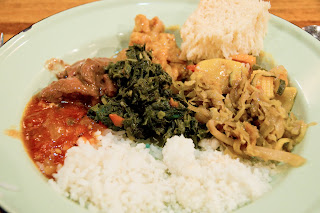The Lesedi Village is about an hour or so drive from Jo'burg and when we arrived, Rose and I amongst other guests were warmly greeted by a troupe of African performers in traditional costume and headwear. We couldn't help but soak up the vibrant atmosphere as we totally immersed ourselves in the colourful environment and people. Needless to say, me and my camera were going wild with all the photo opportunities that were present!
 As we waited for our tour to begin, we browsed through their craft market and were entertained by the performers playing their traditional instruments. The rhythms were vibrant, heart warming and energetic, bringing a crowd of spectators dancing on their toes!
As we waited for our tour to begin, we browsed through their craft market and were entertained by the performers playing their traditional instruments. The rhythms were vibrant, heart warming and energetic, bringing a crowd of spectators dancing on their toes!Listen to this upbeat rhythm of Africa!


Left: A lady in traditional clothes handcrafting with beads.
Right: Lead performer with his beautiful head dress.
Right: Lead performer with his beautiful head dress.
The first homestead we visited was the Zulu tribe. Before entering the homestead we had to greet the Zulu chief at the door in their language before we were allowed to enter.
Left: Zulu watchman. Right: A traditional Zulu home.
In one of the homesteads, a bowl filled with dried mopani worms was distributed for tasting. They looked really curious in the bowl and I knew I had to try this. Without hesitation, I picked one out of the bowl and took a bite... and hey, it tasted like a dried, salty chestnut with the texture of beef jerky! Not too bad at all. I reckon I could eat this as a snack while watching telly. And to think that it's healthy too, as dried Mopane worms are about 60% crude protein, 17% crude fat, and 11% minerals. mmm...
After a tour of a few traditional homesteads we were lead into the dining area where a traditional African buffet and dance performance awaited us.

 Me, Rose and our charming tour guide.
Me, Rose and our charming tour guide. Rose keeping her hands warm by the fireplace while we waited for the show to begin.
Rose keeping her hands warm by the fireplace while we waited for the show to begin.The traditional song and dance was a real treat as the performers were incredibly enthusiastic and humorous as they strut their stuff to a cacophony of drums and whistles. Each performer sang, danced and twirled their tribal weapons at super-sonic speed to the sound of each rhythm. We found ourselves laughing and clapping in time to their beat as we soaked up the highly-charged atmosphere. The dancers seamlessly performed dance rituals from various African tribes and displayed the costumes unique to each ethnic community.
Gumboot dancing originated from South African gold miners. It is an especially upbeat dance as they create their rhythm by slapping their gumboots embellished with bells.
 Zulu dancers with their animal hides and grasses.
Zulu dancers with their animal hides and grasses.
 The Pedi performers with their curious Scottish kilts that strangely didn't look out of place.
The Pedi performers with their curious Scottish kilts that strangely didn't look out of place.
 Xhosa dancers with their white headscarves.
Xhosa dancers with their white headscarves.
Gumboot dancing originated from South African gold miners. It is an especially upbeat dance as they create their rhythm by slapping their gumboots embellished with bells.
The Zulu dance has a more aggressive, warrior-like ritual as they stab the air and slap their shields made of hide with their spears.
African oral history has it that the use of kilts by the Pedi people dates back to 1879. It was said that the tribe lost a battle because its warriors thought the kilted Scots leading the British army were women and failed to attack them until it was too late! Historians have dismissed it as a myth although there were disagreements to the tradition's origin. Either way, who are we to knock back a great story!
Lesedi dining hall.
The dining hall is vibrantly painted and decorated with tribal ornaments. Dishes were beautifully presented and we were quick to learn that ostrich, crocodile and impala meat was on the menu! We tasted all the game meats and they were deliciously tender with no unusual taste or texture to them. All were cooked and marinated so well that we would have thought they were chicken if we didn't know otherwise! We loved every single dish as they were all hearty and incredibly tasty. There were also all sorts of vegetarian dishes, buttered breads, traditional African sausages, meats and rice. We tasted every dish accompanied by some sweet African white wine. Interestingly, when the drinks bill arrived, we discovered that amongst the sodas and bottled vodkas ordered by other visitors, our local African wine was the cheapest drink on the table!
By the time our plates were clean and our wine glasses empty, it was time to head home taking with us the warm, pulsating rhythm of Africa still singing in our hearts and memories.






No comments:
Post a Comment